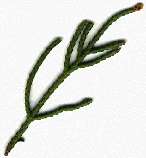
A relatively large tree in habitat, at Point Lobos, California [C.J. Earle, 13-Mar-1998].
Common Names
Monterey cypress, ciprés Monterrey (1).Taxonomic notes
Description
"Trees to 25 m; crown generally broadly spreading, especially on exposed headlands, fairly sparse, often composed of few major limbs from near ground, more upright in sheltered locations. Bark rough, fibrous. Branchlets decussate, 1.5-2 mm diam. Leaves without gland or sometimes with inconspicuous, shallow, pitlike, abaxial gland that does not produce drop of resin, not glaucous. Pollen cones 4-6 × 2.5-3 mm; pollen sacs 6-10. Seed cones oblong, 2.5-4 cm, grayish brown, not glaucous; scales 4-6 pairs, smooth, umbo nearly flat at maturity. Seeds mostly 5-6 mm, dark brown, not glaucous. 2 n = 22" (1).Range
USA: California: the Pacific Coast at Carmel (near Monterey), in two groves, at Cypress Point and Point Lobos (2). See also (7). Due to its rarity, it is of conservation concern. It is known from fossils to have been in other regions. It is much planted and commonly naturalized near the coast from central California north to Washington and in warm temperate and subtropical regions worldwide (1).The species is moderately serotinous. It is normally dependent on fire in its coastal sage scrub habitat to cause opening of cones and dispersal of seeds, but some cones will open under conditions of moderate heat (such as on hot summer days) and some regeneration occurs in unburned habitat. However, fire suppression at Point Lobos is causing low regeneration and prescribed fire treatments will probably be necessary at some time to maintain a wide population age structure.
This species forms both single species and mixed stands. In the latter, its most common associate is another narrow endemic, the Monterey pine ( Pinus radiata).
Big Tree
Curiously, none of the big tree data currently available appear to address specimens in their native habitat. Some examples include: (a) height 32 m, dbh 422 cm, crown spread 34 m; in Pescadero County, CA (3); (b) height 48 m, dbh 122 cm, in San Francisco, CA (4); (c) height 36 m, dbh 320 cm, in Strete Ralegh, Devon, Great Britain (5); (d) a specimen 500 cm in diameter in Pukekura Park, New Zealand (6); and (e) height 48 m, dbh 148 cm, in Tauranga, New Zealand (8).Oldest
A ranger at Point Lobos told me it lives 300 years. No further information.Dendrochronology
No record as of March 1998.Ethnobotany
Observations
The species is widely planted as an ornamental in California and often elsewhere in North America and Europe. In its native range, it is abundant and easily seen at the Point Lobos State Reserve a few miles south of Monterey on State Route 1. A Web search will reveal much information about the Reserve.Remarks
Citations
(1) James E. Eckenwalder at the Flora of North America web site.(2) Peattie 1950.
(4) E-mail communication from Robert Van Pelt, who measured this tree; 18-Mar-1998.
(5) Mitchell et al. 1990.
(6) International Dendrology Society Yearbook 1996. Page 92.
(7) Robert S. Thompson, Katherine H. Anderson and Patrick J. Bartlein. 1999. Atlas of Relations Between Climatic Parameters and Distributions of Important Trees and Shrubs in North America. U.S. Geological Survey Professional Paper 1650 A&B. URL= http://greenwood.cr.usgs.gov/pub/ppapers/p1650-a/pages/conifers.html, accessed 22-Jan-2000.
(8) Burstall & Sale 1984.
[ Cupressus ] [ Cupressaceae ] [ home ]
This page is from the Gymnosperm Database
URL: http://www.geocities.com/~earlecj/cu/cup/macrocarpa.htm
Edited by Christopher J. Earle
E-mail:
earlecj@earthlink.com
Last modified on 22-Jan-2000
